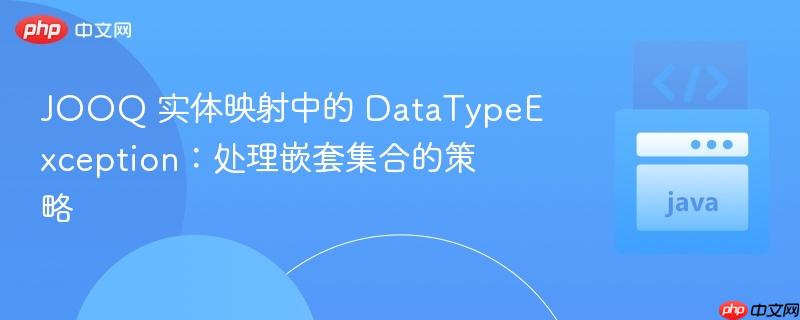
本文深入探讨了在使用jooq进行实体映射时,当尝试将包含一对多关系的扁平化结果集直接映射到带有嵌套集合(如`list
在使用 jOOQ 进行数据查询和实体映射时,开发者可能会遇到 org.jooq.exception.DataTypeException: No Converter found for types java.util.UUID and java.util.List 这样的错误。这个错误通常发生在尝试将一个扁平化的数据库查询结果集(Result)映射到一个包含嵌套集合(例如 List<Comment>)的 Java POJO(Plain Old Java Object)时,特别是当使用 fetchInto(Class) 方法时。
问题的核心在于 jOOQ 的 DefaultRecordMapper(由 fetchInto(Class) 隐式使用)的工作方式。当执行一个包含 LEFT JOIN 的查询,例如连接 POSTS 表和 COMMENTS 表来获取文章及其评论时,如果一篇文章有 N 条评论,那么查询结果将是 N 行,每一行都重复了文章的数据,并包含一条评论的数据。这是一个扁平化的结果集。
例如,对于以下查询和实体结构:
// Entity
class Post {
private UUID id;
private String content;
private Instant createdAt;
private List<Comment> comments; // 嵌套集合
}
class Comment {
private UUID id;
private String content;
private Instant createdAt;
UUID postId;
}
// 查询方法
public List<Post> getAll() {
return dslContext
.select()
.from(POSTS)
.leftJoin(COMMENTS)
.onKey() // 假设 COMMENTS.POST_ID 是 POSTS.ID 的外键
.fetchInto(Post.class); // 尝试直接映射
}当 fetchInto(Post.class) 被调用时,DefaultRecordMapper 会尝试将每一行扁平化的记录映射到 Post 类的实例。对于 Post 类中的 id、content、createdAt 等字段,它可以直接找到对应的数据库列进行映射。然而,当它遇到 List<Comment> comments 字段时,它无法从单一的扁平化数据库行中自动构造一个 List。数据库行中并没有一个类型为 List<Comment> 的列。此时,jOOQ 可能会尝试将某个不兼容的列(例如 UUID 类型的列,如 POSTS.ID 或 COMMENTS.ID)强制转换为 List 类型,从而抛出 DataTypeException。
DefaultRecordMapper 无法智能地识别扁平化结果集中的重复数据,并将其聚合为嵌套集合。它不知道如何将多行中的 Comment 数据关联到同一个 Post 实例的 comments 列表中。
jOOQ 提供了 MULTISET 这一强大且 SQL 惯用的操作符来解决此类问题。MULTISET 允许在主查询中嵌入子查询,并将子查询的结果作为一个集合返回,从而直接在 SQL 层面上构建嵌套的数据结构。结合 jOOQ 的“ad-hoc converters”(即 Records.mapping),我们可以实现从扁平化数据到复杂嵌套实体的高效映射。
以下是使用 MULTISET 解决上述问题的示例代码:
import org.jooq.Records; // 确保导入 Records 类
public List<Post> getAllPostsWithComments() {
return dslContext
.select(
POSTS.ID,
POSTS.CONTENT,
POSTS.CREATED_AT,
// 使用 MULTISET 构建 Comment 集合
multiset(
select(COMMENTS.ID, COMMENTS.CONTENT, COMMENTS.CREATED_AT)
.from(COMMENTS)
.where(COMMENTS.POST_ID.eq(POSTS.ID)) // 关联主查询的 POSTS.ID
).convertFrom(r -> r.map(Records.mapping(Comment::new))) // 将子查询结果映射为 List<Comment>
)
.from(POSTS)
// 最终将整个结果集映射为 List<Post>
.fetch(Records.mapping(Post::new));
}外层 select 和 from(POSTS):
multiset(...):
.convertFrom(r -> r.map(Records.mapping(Comment::new))):
.fetch(Records.mapping(Post::new)):
注意: 为了使 Records.mapping(Comment::new) 和 Records.mapping(Post::new) 能够正常工作,Post 和 Comment 类需要有一个与 select 语句中字段顺序和类型匹配的构造函数。例如:
// Post 实体需要这样的构造函数
class Post {
// ... fields ...
public Post(UUID id, String content, Instant createdAt, List<Comment> comments) {
this.id = id;
this.content = content;
this.createdAt = createdAt;
this.comments = comments;
}
// ... other methods ...
}
// Comment 实体需要这样的构造函数
class Comment {
// ... fields ...
public Comment(UUID id, String content, Instant createdAt) { // 注意这里没有 postId,因为它是外键,不是Comment自身的属性
this.id = id;
this.content = content;
this.createdAt = createdAt;
}
// ... other methods ...
}如果使用 Lombok 的 @AllArgsConstructor,则会自动生成此类构造函数。请确保构造函数参数的顺序与 select 语句中字段的顺序一致。
通过采用 MULTISET,开发者可以优雅地解决 jOOQ 中将扁平化结果集映射到包含嵌套集合的实体时遇到的 DataTypeException,从而构建出更健壮、更高效的数据访问层。
以上就是JOOQ 实体映射中的 DataTypeException:处理嵌套集合的策略的详细内容,更多请关注php中文网其它相关文章!

每个人都需要一台速度更快、更稳定的 PC。随着时间的推移,垃圾文件、旧注册表数据和不必要的后台进程会占用资源并降低性能。幸运的是,许多工具可以让 Windows 保持平稳运行。

Copyright 2014-2025 https://www.php.cn/ All Rights Reserved | php.cn | 湘ICP备2023035733号